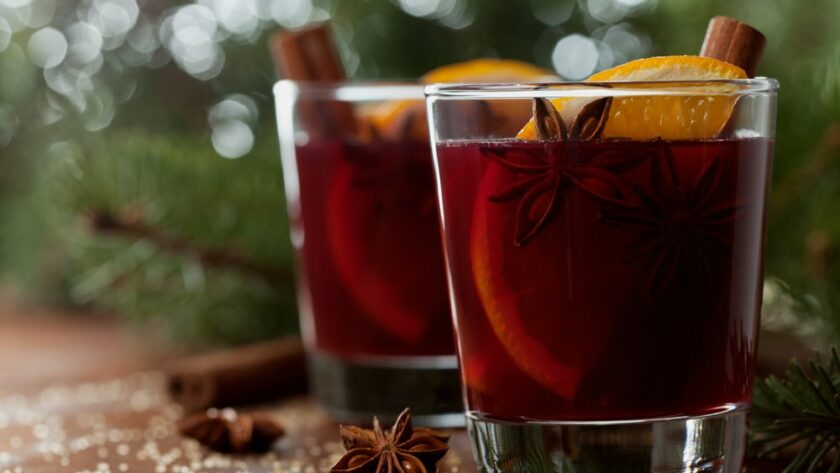This holiday season, as stateside folks celebrate Christmas with peppermint bark, hot chocolate, fruit cake, sugar cookies, and other traditional holiday treats, take a look at popular Christmas traditions around the globe:
Germany – Glühwein

A Christmas market staple in Germany, “Glühwein” translates to “glowing wine.” Traditionally, the recipe combines warmed red wine with mulling spices (like clover and cinnamon), orange juice, sugar, and sometimes a splash of liquor. According to German Missions in the United States, when Glühwein is purchased at these annual Christmas markets, it’s often served in a keepsake mug that features the year and name of the town or city where you purchased your cup of Glühwein on it. Because of its popularity, this beverage can be found throughout Europe, including Austria and France. It’s easy to make at home, too.
Ukraine – Kutia

In addition to Ukraine, kutia is popular in many other Eastern European countries, including Poland and Belarus, and offshoots of kutia can easily be found in nearby countries, too. This dish can be succinctly described as a sweet, cooked pudding made with wheat or barley grains and is traditionally the first of twelve Christmas Eve dinner dishes. Various recipes tend to include wheat berries, chopped pecans or walnuts, dried apricots or raisins, honey, and poppy seeds. Though one Canadian-Ukranian food blogger described kutia as “sweet wheat soup,” she added that “Christmas Eve really wouldn’t be the same in our house without this dish.”
Colombia – Natilla

Natilla colombiano is a traditional Christmas custard in Colombia commonly made with brown sugar, shredded coconut, and corn starch, served chilled. According to Colombia Reports, natilla’s origins are European, and “it is said natilla was first cooked in convents and spread around the world with the conquistadors.” Natilla is often accompanied by buñuelos–fried dough balls with a hint of cheese–and manjar blanco, a sweet rice and milk treat. Though some aren’t keen on the flavor produced by natilla’s cornstarch base, it’s an ingredient that is true to its origins–especially in the home of the arepa!
Chile – Pan de Pascua

Though the name might be confusing (“pascua” translates to Easter, not Christmas), the word is interchangeably used with “Navidad” in Chile — and this is definitely a sweet bread enjoyed at Christmas time. Modern pan de pascua’s origins are actually Italian (panettone) and German (Stollen), a product of German and Italian immigrants mingling with Chile’s own food culture. As one food blogger describes it, “The main Chilean thing is the addition of dulce de leche to the batter.” This treat usually contains honey and ginger and is typically topped with raisins, nuts and dried/candied fruits.
Norway – Lefse

Lefse is a humble, yet widely-loved traditional Norwegian dish, and for Norwegian-Americans, this potato-based flatbread typically makes an appearance during the holidays as a way to honor and celebrate their heritage. Because of its simple ingredients, lefse can be flavored in many ways: with cinnamon, butter, sugar, ham and eggs, or lingonberry jam. Scandinavian food traditions are particularly cherished in the American Midwest, and if you visit Starbuck, Minnesota in May, you can enjoy Lefse Dagen Day, which commemorates the town’s unbroken record for making the largest lefse — that weighed 70 pounds and measured 9’8″ in diameter!
So, alongside your typical Christmas fare, maybe you’ll be inspired to infuse your holiday spread with a few international dishes, too. Happy holidays!
Do you have any holiday treats or Christmas traditions to add to the list? Please share in the comments below.
Recommended:
An Old-Fashioned Christmas: Sweet Traditions for Hearth and Home by Ellen Stimson [Great Reads]
Environmental Expedition Travel Wallet [Travel Style]
Why Picking Olives In Italy Was My Version Of A Spa Retreat [Blog Inspiration]
Latest posts by Paige Sullivan (see all)
- Holiday Treats & Christmas Traditions Around The World - Dec 19, 2016
- Handouts In Developed Nations: Advice For The Responsible Traveler - Jun 7, 2016
- 5 Immersive Culinary Enclaves To Savor In NYC - Feb 18, 2016
- Traveling Responsibly & Protecting Fragile Environments - Jan 9, 2016
- Can Tiger Tourism Be Responsible? - Jan 9, 2016







I have tried the Normay Lefse. It’s more like naan and actually dull than naan. However, it’s really great with a curry side. Wonderful article Thank you.
Lovely article. Thank you for publishing wonderful content! Here’s a coffee
.